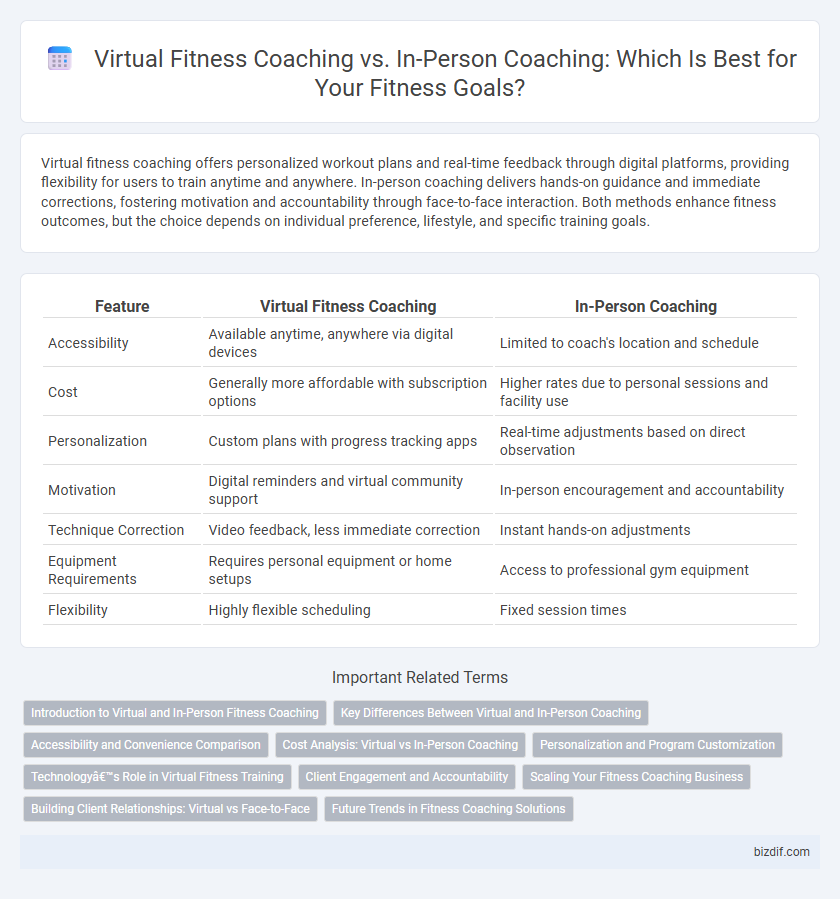Virtual fitness coaching offers personalized workout plans and real-time feedback through digital platforms, providing flexibility for users to train anytime and anywhere. In-person coaching delivers hands-on guidance and immediate corrections, fostering motivation and accountability through face-to-face interaction. Both methods enhance fitness outcomes, but the choice depends on individual preference, lifestyle, and specific training goals.
Table of Comparison
| Feature | Virtual Fitness Coaching | In-Person Coaching |
|---|---|---|
| Accessibility | Available anytime, anywhere via digital devices | Limited to coach's location and schedule |
| Cost | Generally more affordable with subscription options | Higher rates due to personal sessions and facility use |
| Personalization | Custom plans with progress tracking apps | Real-time adjustments based on direct observation |
| Motivation | Digital reminders and virtual community support | In-person encouragement and accountability |
| Technique Correction | Video feedback, less immediate correction | Instant hands-on adjustments |
| Equipment Requirements | Requires personal equipment or home setups | Access to professional gym equipment |
| Flexibility | Highly flexible scheduling | Fixed session times |
Introduction to Virtual and In-Person Fitness Coaching
Virtual fitness coaching offers personalized workout plans and real-time feedback through digital platforms, making it accessible for individuals with busy schedules or limited access to gyms. In-person coaching provides hands-on guidance, immediate correction of form, and motivation through direct human interaction, which can enhance accountability and performance. Both methods utilize expert knowledge to tailor fitness programs, but virtual coaching leverages technology for convenience while in-person coaching emphasizes physical presence and personalized support.
Key Differences Between Virtual and In-Person Coaching
Virtual fitness coaching offers flexible scheduling and access to a diverse range of trainers worldwide, while in-person coaching provides hands-on guidance and immediate physical correction. Virtual sessions often utilize video technology and digital tracking tools to monitor progress, whereas in-person coaching benefits from real-time feedback and personalized workout adjustments. Differences also include varying costs, with virtual coaching generally being more affordable and in-person sessions typically requiring travel and higher fees.
Accessibility and Convenience Comparison
Virtual fitness coaching offers unparalleled accessibility by allowing clients to train anytime and anywhere, eliminating geographical limitations and reducing travel time. In-person coaching provides direct, hands-on guidance and immediate feedback, but often requires scheduling around fixed gym hours and commuting. Convenience in virtual coaching is boosted by flexible session times and digital tracking tools, making it ideal for busy lifestyles, whereas in-person sessions demand consistent physical presence.
Cost Analysis: Virtual vs In-Person Coaching
Virtual fitness coaching often offers a more cost-effective solution compared to in-person coaching due to lower overhead expenses and flexible subscription models. In-person coaching typically involves higher costs related to facility fees, personalized equipment use, and travel time. Evaluating cost per session and long-term investment highlights virtual coaching as a budget-friendly alternative without compromising access to professional guidance and customized workout plans.
Personalization and Program Customization
Virtual fitness coaching offers advanced algorithms and data analytics to tailor workout plans based on individual performance metrics and progress tracking, ensuring highly personalized program customization. In-person coaching enables hands-on assessment and real-time adjustments to exercise form and intensity, providing immediate feedback that fine-tunes personalized training. Both methods prioritize customization, but virtual coaching leverages technology for scalable personalization, while in-person coaching relies on direct interaction for nuanced program adaptation.
Technology’s Role in Virtual Fitness Training
Virtual fitness coaching leverages advanced technology such as AI-driven workout analytics, real-time performance tracking, and personalized feedback through mobile apps to deliver tailored training experiences. Wearable devices and smart equipment synchronize with virtual platforms to enhance engagement and monitor biometric data like heart rate and calorie expenditure accurately. This integration of technology enables scalable, flexible, and data-driven fitness coaching that adapts dynamically to individual progress and goals.
Client Engagement and Accountability
Virtual fitness coaching leverages real-time video sessions and app-based tracking to maintain high client engagement through personalized feedback and progress monitoring. In-person coaching offers immediate hands-on correction and face-to-face interaction, which can enhance motivation and commitment. Accountability is reinforced virtually via digital reminders and performance analytics, while in-person settings rely on direct presence and social cues to sustain client responsibility.
Scaling Your Fitness Coaching Business
Virtual fitness coaching enables scalable growth by leveraging digital platforms to reach a wider client base without geographic limitations, reducing overhead costs compared to in-person coaching. Automated scheduling, progress tracking apps, and personalized video sessions streamline client management and enhance engagement at scale. While in-person coaching offers hands-on interaction, virtual coaching's flexibility and data-driven tools provide significant advantages for expanding a fitness business efficiently.
Building Client Relationships: Virtual vs Face-to-Face
Virtual fitness coaching leverages digital platforms to maintain consistent communication, offering flexibility and personalized feedback through video calls and apps that track progress. In-person coaching facilitates immediate physical adjustments and fosters deeper emotional connections by enabling direct observation and real-time motivational support. Both methods prioritize client engagement, but face-to-face interactions generally enhance trust and accountability through personal presence.
Future Trends in Fitness Coaching Solutions
Virtual fitness coaching leverages AI-driven personalized workouts and real-time biometric feedback, enhancing accessibility and customization beyond traditional in-person coaching. Integration of augmented reality (AR) and virtual reality (VR) technologies is expected to create immersive training environments, revolutionizing user engagement and motivation. Hybrid models combining both virtual and physical sessions will likely dominate future fitness coaching, optimizing convenience and personalized support.
Virtual fitness coaching vs In-person coaching Infographic

 bizdif.com
bizdif.com